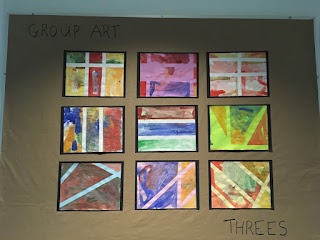3 Yr Old Class & 4 Yr Old Class
The children recently did balloon painting in class. We used
large balloons with just a little air inside thus allowing the children to
squish and bounce the balloons with no threat of their popping. This activity
seemed to encourage children, who otherwise preferred to not get paint on their
hands, to participate and begin to appreciate the fun in getting messy.
Another activity recently
implemented in class, involved oil, a food-coloring and water mix, and
droppers. The children seemed to enjoy this fine-motor activity. Learning to
use the droppers and suck up the food coloring mix, was a learning curve, but
most caught on with minimal guidance. The children seemed intrigued watching
the drops of colour float around in the oil, and had fun mixing all the colors
together, making loads of smaller drops.
On this day, light colored paper
was placed on the table and paper-tape was used to secure the paper and to make
lines on the paper. The 3's Class worked as a group to freely cover the paper
with water paint. At the end of class, after the paint had mostly dried, the
tape was removed with the children, revealing a very cool effect.
We, the teachers, are having a very
enjoyable time watching the Preschoolers learn fine and gross motor skills,
self-help and social skills, be creative and gain confidence, and... make new friends.
Until next time,
Barbi











Comments